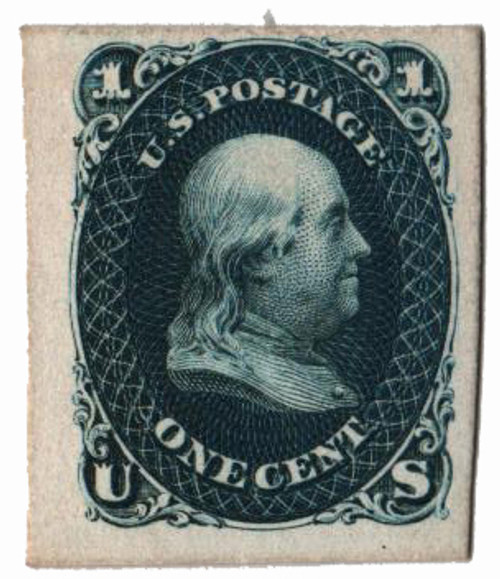
# 92a - 1867 1c pale blue
U.S. #92a
Series of 1867 1¢ Franklin
“F” Grill
Earliest Known Use: August 11, 1868
Printed by: National Bank Note Company
Method: Flat plate
Watermark: None
Perforation: 12
Color: Pale Blue
Grills were made by embossing the stamp, breaking paper fibers, and allowing canceling ink to soak deeply into the paper. This made it difficult to remove cancels and reuse stamps. Charles Steel, who oversaw postage stamp production in the 1860s, patented the grilling method. It was used nine short years – 1867 to 1875. Grilling resulted in some of the greatest U.S. stamp rarities, including the legendary “Z” Grill U.S. #85A.
Series of 1867
Grills are classified by the dimensions of the grill pattern and are measured in millimeters or by counting the number of grill points. There are eleven major classifications.
“A” Grill Covers the entire stamp
“B” Grill 18x15mm (22x18pts)
“C” Grill 13x16mm (16-17x18-21pts)
“D” Grill 12x14mm (15-17-18pts)
“Z” Grill 11x14mm (13-14x18pts)
“E” Grill 11x13mm (14x15-17pts)
“F” Grill 9x13mm (11-12x15-17pts)
“G” Grill 9 ½ x9mm (12x11-11 ½ pts)
“H” Grill 10x12mm (11-13x14-16pts)
“I” Grill 8 ½ x10mm (10x11x10-13pts)
“J” Grill 7x9 ½ mm (10x12pts)
The letters that classify the various grill types do not denote the size, shape, or appearance of the grills. Rather, they simply indicate the order in which they were discovered.
The exception to the rule is the “Z” grill, which was identified by William L. Stevenson. Stevenson could not decide to which family of grills this particular type belonged. Nor did he know which other families it preceded or followed and so he designated it as “Z Grill,” where “Z” signifies the unknown.
Visible in general from the back of the stamp only, grills may also be felt by lightly running a fingertip over the surface. Depending on which type of roller was used, the pattern may be “points up” or a “points down.” The ridges on an indented roller force the paper into the recesses, creating raised points, while a roller with raised pyramids will cause the points to be forced down into the paper, forming a series of depressions.
The United States was the first country to issue grilled stamps and was the only country to do so until the mid-1870s, when Peru also began using grills. The National Bank Note Company was responsible for producing both countries’ stamps.
U.S. #92a
Series of 1867 1¢ Franklin
“F” Grill
Earliest Known Use: August 11, 1868
Printed by: National Bank Note Company
Method: Flat plate
Watermark: None
Perforation: 12
Color: Pale Blue
Grills were made by embossing the stamp, breaking paper fibers, and allowing canceling ink to soak deeply into the paper. This made it difficult to remove cancels and reuse stamps. Charles Steel, who oversaw postage stamp production in the 1860s, patented the grilling method. It was used nine short years – 1867 to 1875. Grilling resulted in some of the greatest U.S. stamp rarities, including the legendary “Z” Grill U.S. #85A.
Series of 1867
Grills are classified by the dimensions of the grill pattern and are measured in millimeters or by counting the number of grill points. There are eleven major classifications.
“A” Grill Covers the entire stamp
“B” Grill 18x15mm (22x18pts)
“C” Grill 13x16mm (16-17x18-21pts)
“D” Grill 12x14mm (15-17-18pts)
“Z” Grill 11x14mm (13-14x18pts)
“E” Grill 11x13mm (14x15-17pts)
“F” Grill 9x13mm (11-12x15-17pts)
“G” Grill 9 ½ x9mm (12x11-11 ½ pts)
“H” Grill 10x12mm (11-13x14-16pts)
“I” Grill 8 ½ x10mm (10x11x10-13pts)
“J” Grill 7x9 ½ mm (10x12pts)
The letters that classify the various grill types do not denote the size, shape, or appearance of the grills. Rather, they simply indicate the order in which they were discovered.
The exception to the rule is the “Z” grill, which was identified by William L. Stevenson. Stevenson could not decide to which family of grills this particular type belonged. Nor did he know which other families it preceded or followed and so he designated it as “Z Grill,” where “Z” signifies the unknown.
Visible in general from the back of the stamp only, grills may also be felt by lightly running a fingertip over the surface. Depending on which type of roller was used, the pattern may be “points up” or a “points down.” The ridges on an indented roller force the paper into the recesses, creating raised points, while a roller with raised pyramids will cause the points to be forced down into the paper, forming a series of depressions.
The United States was the first country to issue grilled stamps and was the only country to do so until the mid-1870s, when Peru also began using grills. The National Bank Note Company was responsible for producing both countries’ stamps.










